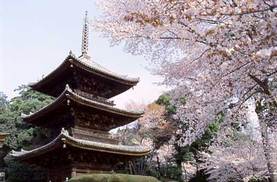 kurumaisu.service.kansai.nttdocomo.co.jp
kurumaisu.service.kansai.nttdocomo.co.jp It is interesting to learn what Fushimi castle once looked like, not least because the modern version of Fushimi castle is little more than a tourist attraction, a simple keep in the late Sengoku style but not all that spectacular (the fact that it is just outside Fushimi, which is now a neighbourhood of Kyoto rife with apartment blocks, middle to lower income housing, gambling parlours, and the occasional bōryokudan hideout, doesn’t add anything to the historical atmosphere that should surround such a landmark.)
What is more interesting about the article translated below is the fact that the three tiered pagoda that once graced the grounds of Fushimi castle is now located within the Mii-dera temple complex outside Otsu City in Shiga prefecture. When I was living in Yamashina ward in 2008, Otsu City was a mere 6 or 7 minute train ride over the border from Kyoto City. In late Autumn I paid a visit to Mii-dera and saw the very three tiered pagoda referred to below. It’s an impressive structure, and the details of its past make it even more fascinating.
Fushimi castle – The black-lacquered keep that sparkled with gold (first appeared in the Yomiuri Shimbun homepage as follows: 金箔輝く漆黒の天守・伏見城 秀吉編<10>) http://www.yomiuri.co.jp/chubu/feature/CO012894/20150329-OYTAT50030.html
Toyotomi Hideyoshi was responsible for moving the ‘aristocratic’ castle of Jūrakudai from its original location in Hirano-gun in Heian-Kyo (the old title for Kyoto) to a mountain top at Fushimi, south of Kyoto.
The castle at Fushimi (upon which work commenced in 1594 and was completed soon after. The castle later collapsed in an earthquake and had to be rebuilt in 1597) possessed panoramic views of the surrounding countryside in a similar manner to Oda Nobunaga’s former castle at Azuchi. One could say that for Hideyoshi, who died the year after reconstruction of Fushimi castle was completed, Fushimi was the sum of his life as a warrior.
However we do not know what the actual appearance of the keep at Fushimi castle was. This is because in the aftermath of the Battle of Sekigahara in 1600, Fushimi castle was burnt to the ground. There are around 10 or so folding screen prints that depict Fushimi castle, yet all of these depict the keep of Fushimi with white-washed walls in a similar manner to the keeps at Nagoya castle and Himeji castle. This suggests that the keep depicted in the screens was one that was rebuilt by Tokugawa Ieyasu after Sekigahara.
However, in 2010 the Nagoya City Museum put on display for the first time a folding screen that depicts scenes of Kyoto both within and outside the capital. In this screen, Fushimi castle is depicted with black lacquered walls. According to Tsuda Takako, an art curator at the Museum, “This is a very valuable artwork that almost certainly depicts the castle at Fushimi as it appeared in Hideyoshi’s time, of which there are very few examples”.
Yet not all black-lacquered keeps were limited to the era of Hideyoshi. What confirmed that it is of Hideyoshi’s time is the presence in the picture of a three-tiered pagoda. According to the Chancellor of Nara University (and castle archaeological expert) Senda Yoshihiro, who was the first to indicate the importance of the pagoda…”Hideyoshi, when he moved to Fushimi, also moved a three-tiered pagoda from Nara to the same location. After Hideyoshi’s death, Ieyasu donated that pagoda to another temple. Hence could it be the same pagoda?” That three tiered pagoda is currently the property of Mii-dera (just outside Otsu City in Shiga prefecture), the main temple of the Tendai Jimonshū sect of Tendai Buddhism, and has been designated as an important national heritage site.
The folding screen picture held by Nagoya City Museum also depicts the walls of Fushimi castle as being inlayed with gold coloured designs. This is similar to the depiction of Osaka castle in the “Osaka Castle Folding Screen Print” that dates from the Hideyoshi era, yet the Fushimi castle design is very unique. It is for this reason that some experts believe that the design in the picture was artistic licence and is not how the walls of Fushimi castle actually appeared in their heyday.
Yet according to Professor Senda’s explanation “The walls of the main shrine of Tsukubusama shrine, located on Chikubushima on Lake Biwa, uses the same wooden relief carving decoration used on Fushimi castle (as the materials for the shrine came from Fushimi castle). It is therefore possible that the same relief, which was decorated in gold leaf, was used on the keep of Fushimi castle”. If this is true, then it would be in keeping with Hideyoshi’s sense of taste, with his preference for gaudy display (such as his gold-leaf decorated tea room).
Fushimi castle, which was steeped in Hideyoshi’s own personality and his martial nature, was linked with Osaka castle (which was a ‘private’ castle compared to Fushimi) via Lake Ogura (which was located in front of Fushimi castle, and which has since dried up and disappeared) and the Yodogawa river. When Fushimi was completed, Hideyoshi took up residence there with his 5 year old son Hideyori, and came so close to realising his ambition of becoming ruler (in Fushimi castle) together with his household (in Osaka castle). Yet after Hideyoshi’s death, Hideyori returned to the secure walls of Osaka castle, and in his stead Tokugawa Ieyasu took up residence at Fushimi.
The aristocratic power that Fushimi castle possessed was eventually diminished by either Ishida Mitsunari, or else Hideyoshi’s concubine Yododono. Then again, Hideyoshi himself may have been responsible for Fushimi’s eventual demise, given the reputation of Osaka castle for being impregnable and thus the most appropriate residence for Hideyori.
(Okamoto Kōki)
 RSS Feed
RSS Feed